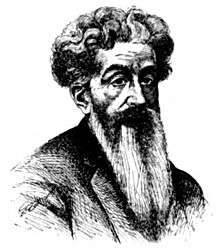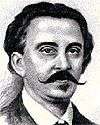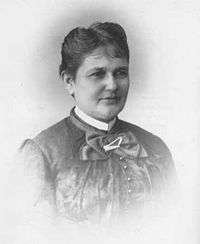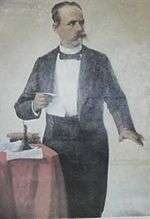Grito de Lares
| Grito de Lares | |||||||
|---|---|---|---|---|---|---|---|
|
|
The Grito de Lares (English: Cry of Lares)—also referred to as the Lares uprising, the Lares revolt, the Lares rebellion, or the Lares revolution—was the first major revolt against Spanish rule in Puerto Rico. The short-lived revolt was planned by Ramón Emeterio Betances and Segundo Ruiz Belvis. It began on September 23, 1868, in the town of Lares, for which it is named, and spread rapidly to various revolutionary cells throughout the island.
Seeds for revolt
In the 1860s, the government of Spain was involved in several conflicts across Latin America. It became involved in a war with Peru and Chile, and had to address slave revolts in Cuba. At the time, Puerto Rico and Cuba also suffered a severe economic crisis, due to increasing tariffs and taxes imposed by the Spanish central government on most import and export goods—the Spanish crown needed these funds badly, to subsidize its troops in the Dominican Republic.
In mid-19th century Puerto Rico, many supporters of independence from Spain, as well as others who did not support independence from Spain, but who simply called for liberal reforms, were jailed or exiled. However, in 1865, the central government in Madrid, finally attempted to appease the growing discontent in all its overseas provinces by setting up a "board of review" to receive complaints from provincial representatives. This board, the Junta Informativa de Reformas de Ultramar (Informative Board on Overseas Reforms) would be formed by representatives of each overseas province, in proportion to their collective population. The board would meet in Madrid, then report to the Minister of State (Ministro de Estado), Emilio Castelar.[1][2]
The Puerto Rican delegation was freely elected by those eligible to vote (male Caucasian property owners), in what was one of the first exercises of political openness in Spain. Separatist Segundo Ruiz Belvis was elected to the Junta representing Mayagüez, something that horrified the governor of Puerto Rico as well as most of residents of the island, since the majority of Puerto Ricans did not support independence from the rest of Spain.[1][2]
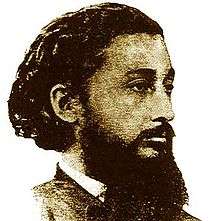
To the frustration of the Puerto Rican delegates, including their leader José Julián Acosta, the Junta had a majority of mainland Spain-born delegates, which would vote down almost every measure they suggested, including the measure on the abolition of slavery. However, Acosta could convince the Junta that abolition could be achieved in Puerto Rico without disrupting the local economy (including its Cuban members, who frowned upon implementing it in Cuba because of its much higher numbers of slave labor). Emilio Castelar y Ripoll, once he became minister for foreign affairs in 1870, finally approved an abolition bill, praising the efforts of the Puerto Rican members, sincerely moved by Acosta's arguments.[1][2]
Beyond abolition however, proposals for autonomy were voted down, as were other petitions to limit the governor general's power over virtually every aspect of life in Puerto Rico. Once the Junta members returned to Puerto Rico, they met with local community leaders in a famed meeting at the Hacienda El Cacao in Carolina, in early 1865.
Ramón Emeterio Betances, who supported independence from Spain and had been exiled by the Spanish government twice by that time, was invited by Ruiz and did attend. After listening to the Junta members' list of voted-down measures, Betances stood up and retorted: "Nadie puede dar lo que no tiene" (You can't give away what you don't own),[3] a phrase he used throughout his entire life, when referring to Spain's unwillingness to grant Puerto Rico or Cuba any reforms.
Betances then suggested an outright, island-wide rebellion, with a proclamation of independence as soon as possible.[3] To Acosta's horror, many of the meeting's attendees sided with Betances.
Frustrated by the lack of political and economic freedom, by the continuing repression on the island - all of this caused by the extreme centralism of the Spanish central government in Madrid - an armed rebellion was staged by the pro-independence movement soon after.
Rebellion
Planning stage
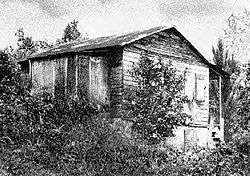
The Lares uprising, commonly known as the Grito de Lares, occurred on September 23, 1868, but was planned well before that date. A group led by Dr. Ramón Emeterio Betances and Segundo Ruiz Belvis founded the Revolutionary Committee of Puerto Rico (Comité Revolucionario de Puerto Rico) on January 6, 1868 from their exile in the Dominican Republic.
Betances authored several Proclamas, or statements attacking the exploitation of the Puerto Ricans by the Spanish centralist system and called for immediate insurrection. These statements soon circulated throughout the island as local dissident groups began to organize.[4] Among them, Los Diez Mandamientos de los hombres libres (English: The Ten Commandments of Free Men) written in exile in Saint Thomas in November 1867.[5][6] It is directly based on the Declaration of the Rights of Man and of the Citizen, adopted by France's National Assembly in 1789, which contained the principles that inspired the French Revolution.[7]

That same year, poet Lola Rodríguez de Tió, inspired by Ramón Emeterio Betances's quest for Puerto Rico's independence, wrote the patriotic lyrics to the existing tune of La Borinqueña, Puerto Rico's national anthem.
Eduvigis Beauchamp Sterling, named Treasurer of the revolution by Betances, provided Mariana Bracetti with the materials for the Revolutionary Flag of Lares.[8] The flag was divided in the middle by a white Latin cross, the two lower corners were red and the two upper corners were blue. A white star was placed in the upper left blue corner.[9] According to Puerto Rican poet Luis Lloréns Torres the white cross stands for the yearning for homeland redemption; the red squares, the blood poured by the heroes of the rebellion and the white star in the blue solitude square, stands for liberty and freedom.[10]
Secret cells of the Revolutionary Committee were established in Puerto Rico by Mathias Brugman, Mariana Bracetti and Manuel Rojas bringing together members from all sectors of society including landowners, merchants, professionals, peasants, and slaves. Most were criollos (Caucasians born on the island).
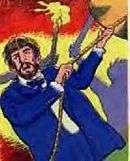
The Revolutionary Committee named twelve of their members as generales (generals).[11] They were:
- Manuel Rojas, Commander-in-Chief of the Liberation Army
- Andrés Pol, General of Division
- Juan de Mata Terraforte, General of Division
- Joaquín Parrilla, General of Division
- Nicolás Rocafort, General of Division
- Gabino Plumey, General of Division
- Dorvid Beauchamp, General of Division
- Mathías Brugman, General of Division
- Rafael Arroyo, General of Division
- Francisco Arroyo, General of Division
- Pablo Rivera, Cavalry General
- Abdón Pagán, Artillery General
The critical state of the economy, slavery, and the increasing political repression from the Spanish central government, served as catalysts for the rebellion.
The stronghold of the movement were towns located in the mountains, on the western part of the island.
On September 20, Francisco Ramírez Medina held a meeting at his house in which the insurrection was planned and set to begin in Camuy on September 29. The meeting was attended by Marcelino Vega, Carlos Martínez, Bonifacio Agüero, José Antonio Hernández, Ramón Estrella, Bartolomé González, Cesilio López, Antonio Santiago, Manuel Ramírez, Ulises Cancela. Cancela instructed Manuel María González to deliver all of the acts and important papers in regard to the meeting to Manuel Rojas.[12]
Juan Castañón, a captain stationed in Quebradillas, overheard two cell members commenting that on September 29 the troops at Camuy would be neutralized by poisoning the bread rations. Given the fact that September 29 would be a holiday for most laborers, simultaneous uprisings would occur, beginning with the cell in Camuy, and following with the ones in various other points; reinforcements would arrive on a ship, El Telégrafo, and the cells would be reinforced by more than 3,000 mercenaries. Castañón and his men then entered González's residence and confiscated the documents of Medina's meeting and alerted his commanding officer in Arecibo. The cell leaders at the Lanzador del Norte cell in Camuy were soon arrested.
On another front, the Dominican government had supported Ramón Emeterio Betances. They allowed him to recruit a small army, and gave him a ship containing weapons. However, when the ship was about to sail, the Spanish government made its move. It prohibited the ship's departure from Dominican territory. The authorities in Saint Thomas, U.S. Virgin Islands, where the ship was anchored, boarded the vessel and confiscated its cargo.
Seeing their plans disrupted, the other leaders feared arrest. They decided to change the date of the revolution for an earlier one without consulting Betances.[4]
Proclamation of the Republic of Puerto Rico

The leaders decided to start their revolution in the town of Lares on September 23. Some 400–600 rebels gathered on that day in the hacienda of Manuel Rojas, located in the vicinity of Pezuela, on the outskirts of Lares. Led by Rojas and Juan de Mata Terraforte, the poorly trained and sparsely armed rebels reached the town by horse and foot around midnight. They looted local stores and offices owned by peninsulares (Spanish mainland-born men) and took over the city hall. Spanish mainland-born merchants and Puerto Rican government authorities, considered by the rebels as enemies of the fatherland, were taken as prisoners.
The rebels then entered the town's church and placed the revolutionary flag of Lares on the High Altar. This was the sign that the revolution had begun. The Republic of Puerto Rico was proclaimed at (2:00 am local time) under the presidency of Francisco Ramírez Medina at the church and the revolutionaries offered freedom to the slaves who joined them. President Ramírez Medina appointed Government officials as follows:
- Francisco Ramírez Medina, President
- Aurelio Méndez, Minister of the Interior
- Manuel Ramírez, Minister of State
- Celedonio Abril, Minister of the Treasury
- Federico Valencia, Minister of War
- Clemente Millán, Minister of Justice
- Bernabé Pol, Secretary to the President
- Manuel Rojas, Commander in Chief of the Liberation Army
Confrontation at San Sebastián
The next day, on September 24, the rebel forces departed to take over the next town, San Sebastián del Pepino. The Puerto Rican militia surprised them with strong resistance, by moving troops from San Juan, Mayagüez, Ponce, and several other towns. This caused confusion amongst the rebels, who were greatly disadvantaged without the weapons provided by Betances.
The insurgents retreated back to Lares. Upon an order from the governor, Julián Pavía, the militia soon rounded them up, and the insurrection was over.
Trials and amnesty
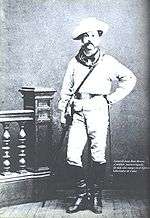
Some 475 rebels, among them Dr. José Gualberto Padilla (leader of the Arecibo cell), Manuel Rojas and Mariana Bracetti were imprisoned in Arecibo, where they were tortured and humiliated. On November 17, a military court imposed the death penalty, for treason and sedition, on all the prisoners.
Meanwhile, in Madrid, Eugenio María de Hostos and other prominent Puerto Ricans were successful in interceding with President Francisco Serrano, who had himself just led a revolution against the monarchy in Spain. In an effort to appease the already tense atmosphere on the island, the incoming governor, José Laureano Sanz, dictated a general amnesty early in 1869 and all prisoners were released. However Betances, Rojas, Lacroix, Aurelio Méndez, and many others were sent into exile.[10]
As a young man, Juan Ríus Rivera met and befriended Betances, and joined the pro-independence movement in the island. He became a member of the Mayagüez revolutionary cell Capá Prieto under the command of Brugman. Although he was studying law in Spain, and therefore had not participated in the Lares uprising, Ríus Rivera was an avid follower of Caribbean politics. When he learned about the failed revolt, he interrupted his law studies and traveled to the United States, where he immediately went to the Cuba Revolutionary Junta and offered his services. Juan Ríus Rivera went to Cuba and became the Commander-in-Chief of the Cuban Liberation Army of the west after General Antonio Maceo's death.
Mariana Bracetti moved to the town of Añasco, where she died in 1903.[13]
Aftermath
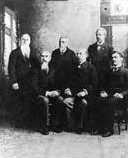
(standing L-R) Manuel Besosa, Aurelio Méndez Martínez, and Sotero Figueroa (seated L-R) Juan de Mata Terreforte, Dr. Jose Julio Henna and Roberto H. Todd
Although the revolt failed to achieve its main objective, the Spanish government granted more political autonomy to the island.
During the years immediately following the Grito, there were minor pro-independence protests and skirmishes with the Spanish authorities in Las Marías, Adjuntas, Utuado, Vieques, Bayamón, Ciales and Toa Baja (Palo Seco).[14]
Juan de Mata Terreforte, who fought alongside Manuel Rojas, was exiled to New York City. He joined the Puerto Rican Revolutionary Committee and was named its Vice-President.[10] Terreforte and the members of the Revolutionary committee adopted the Flag of Lares as the flag of Puerto Rico until 1892, when the current design, modeled after the Cuban flag, was unveiled and adopted by the committee.[10]
The Grito de Lares as a holiday
Commemorating the Grito de Lares as a holiday was outlawed in Puerto Rico by both the Puerto Rican/Spanish and American administrations, during different time periods.
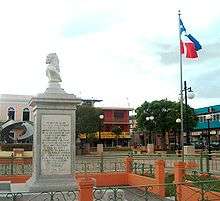
In the late 1920s members of the Nationalist Party of Puerto Rico staged minor celebrations in the town of Lares as both historical and fund-raising efforts. When Pedro Albizu Campos gained control over the party, "frivolous" activities related to the Grito (such as the yearly fundraising dance) were terminated, and a series of rituals to commemorate the event in a dignified manner were instituted. One of Albizu's better known quotes is: "Lares es Tierra Santa, y como tal, debe entrarse a ella de rodillas" ("Lares is Sacred Ground, and as such, it must be entered on your knees").
Key to the rituals associated with the Grito is the gift, given by Chilean writer Gabriela Mistral to Albizu's family, of a tamarind tree obtained from Simón Bolívar's estate in Venezuela. The tree was planted at the Plaza de la Revolución with soil taken from the eighteen other Spanish-speaking Latin American countries. Albizu meant to give the Plaza a living symbol of solidarity with the struggle for freedom and independence initiated by Bolivar (who, while visiting Vieques, promised to assist the Puerto Rico independence movement, but whose promise never materialized due to the simple fact that most Puerto Ricans did not want the island's independence from Spain), as well as a symbol of the bittersweet (as the trees' fruit) hardships needed to reach Puerto Rico's independence. As such, the Tamarindo de Don Pedro was meant to resemble the Gernikako Arbola in the Basque Country between Spain and France.
In 1969, under the administration of Governor Luis A. Ferré (not an independence supporter, he was a US statehood supporter), Lares was declared a Historic Site by the Institute of Puerto Rican Culture, and is known as the birthplace of Puerto Rican nationalism.
Photo gallery
| People directly or indirectly involved with the revolt | ||||||||||||||||
|---|---|---|---|---|---|---|---|---|---|---|---|---|---|---|---|---|
|
See also
- Military history of Puerto Rico
- Ramón Emeterio Betances
- Ducoudray Holstein Expedition
- Intentona de Yauco
- Puerto Rican Campaign
- Puerto Rican Nationalist Party Revolts of the 1950s
- Ponce massacre
- Río Piedras massacre
- Jayuya Uprising
- Utuado Uprising
- Puerto Rican Independence Party
- Puerto Rican Nationalist Party
- List of Puerto Rican military personnel
- List of revolutions and rebellions
References
- 1 2 3 "Junta Informativa de Reformas « Puerto Rico: su transformación en el tiempo".
- 1 2 3 "Junta Informativa de Ultramar"; Author Spain. Ministerio de Ultramar; Publisher: Imp. de la Biblioteca Universal Economica, 1869
- 1 2 Revista del Colegio de Abogados de Puerto Rico; Vol. 63, Num 1; January 2002; "El Mito Americano"; pg. 1; by Alberto Medina Carrero
- 1 2 Pérez Morís, José; Cueto y González Quijano, Luis (1872). Historia de la Insurrección de Lares (in Spanish). Establecimiento Tipográfico de Narciso Ramírez y Compañía.
- ↑ Emeterio Betances, Ramón (November 1867). "Proclama de los Diez Mandamientos de los Hombres Libres" (in Spanish). Biblioteca Digital Ciudad Seva. Retrieved January 21, 2014.
- ↑ Ojeda Reyes, Félix, El Desterrado de París, p. 103. The original manuscript is owned by the Puerto Rican Independence Party, which bought it in 1985.
- ↑ Moscoso, Francisco, Betances, El Grito y St. Thomas.
- ↑ Rodríguez, Kathy. "Beauchamp history" (PDF). 13.3. Nuestra Herencia. Retrieved January 21, 2014.
- ↑ The Women from Puerto Rico. Mariana Bracetti. Retrieved on September 26, 2007. Archived July 8, 2008, at the Wayback Machine.
- 1 2 3 4 "Grito de Lares 1868". Encyclopedia of Puerto Rico. Fundación Puertorriqueña de las Humanidades.
- ↑ Historia militar de Puerto Rico, Coleccion Encuentros bBy Negroni, Hector Andres (1992) (Spanish); publisher: Sociedad Estatal Quinto Centenario. ISBN 84-7844-138-7
- ↑ El Pueblo de Lares Antes de la Rebelion de 1868. Las Conspiraciones y Sus Causas by Francisco Modesto Berroa Ubiera, Professor of the Escuela de Historia, and former director of the institute of History of the Humanities Faculty of the Autonumous University of Santo Domingo (Spanish)
- ↑ Madrinas to us all: Significant Latinas in history
- ↑ Moscoso, Francisco, as quoted by Collado Schwarz, Ángel, Voces de la Cultura, Fundación La Voz del Centro, San Juan, Puerto Rico, 2005
